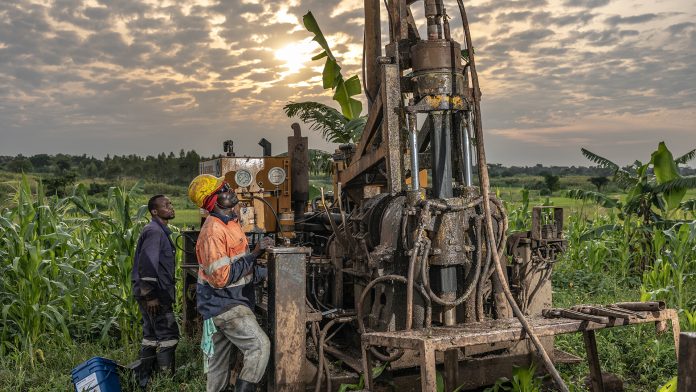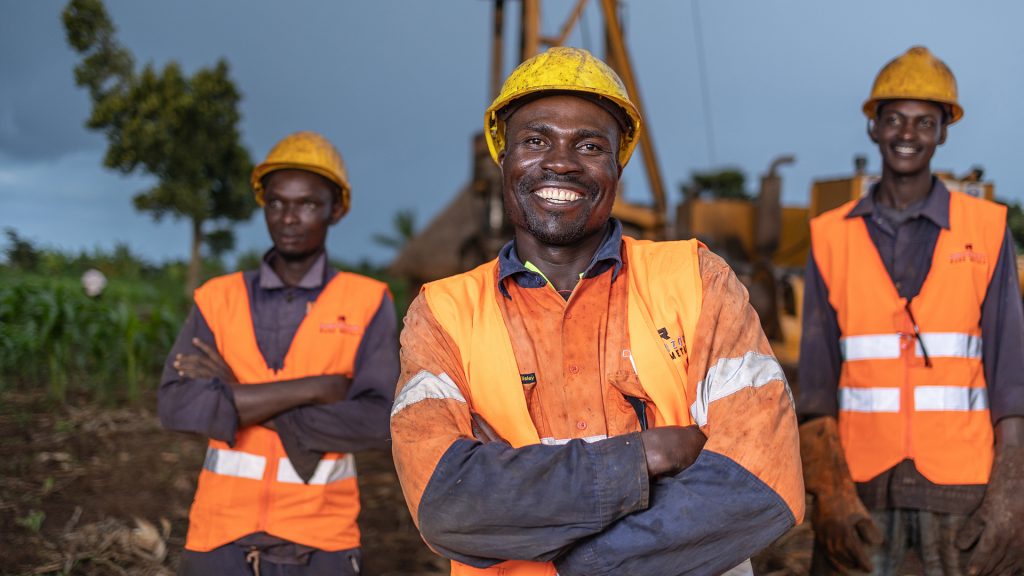From its magnet and heavy rare earth dominant Makuutu Project, Ionic Rare Earths is progressing downstream ambitions in building a new magnet and heavy rare earth supply chain.
Ionic Rare Earths (ASX:IXR, ‘IonicRE’) is an exploration and mining development company that aims to rapidly produce secure and traceable magnet and heavy rare earth supplies from its Makuutu rare earths project in Uganda.
IonicRE is also advancing plans on developing its downstream processing capability. This would include the development of a standalone rare earth refinery capable of separating magnet and heavy rare earths that make up 73% of its basket and the potential development for value-added metals and alloys to supply into Western markets.
Around the world, governments are setting bold targets to cut emissions and increase renewable energy installations. To achieve such ambitious targets, the supply of critical raw materials crucial for technologies such as wind turbines and electric vehicles (EVs) will have to be ramped up over the remainder of this decade to 2030 and beyond. The most urgent requirement is sustainably sourced new magnet rare earth supply; neodymium (Nd), praseodymium (Pr), dysprosium (Dy) and terbium (Tb). These will be the elements that literally will drive the revolution. Magnet rare earth elements are essential for the permanent magnet motors that make EVs and offshore wind turbines operate. This magnet rare earth content provides IonicRE with a significant advantage over its peers.
Additionally, IonicRE has also recently announced plans to acquire Seren Technologies Limited (SerenTech), a UK-based company with a unique technology that enables the separation of individual rare earths using ionic liquids. SerenTech has also developed recycling technology, which uniquely can extract, separate and refine magnet rare earths from spent and waste permanent magnets. The planned acquisition of SerenTech significantly differentiates IonicRE from other rare earth project developers in the sector, providing the scope for near term low-cost vertical integration in the magnet rare earth industry that has the potential to make IonicRE a pivotal player to 2030 and beyond.
Developing a new magnet and heavy rare earth supply source
The unique potential basket produced at Makuutu, which contains an astonishing 43% magnet rare earths, including a near-perfect split of main magnet rare earths Nd, Pr, Dy and Tb, provides IonicRE with a significant opportunity to realise downstream value addition. The low capital development potential of the Makuutu Project, coupled with a substantial looming deficit in the supply of magnet rare earths in the near term, along with the 44% heavy rare earth content, is expected to provide an opportunity for the company to participate meaningfully in the vertical integration of new supply chains. These supply chains will need to be created in the coming years to achieve the ambitions of global government policies and meet climate targets by 2050.
IonicRE is now adding the individual processing components and advancing discussions with potential global partners in developing new supply chains to build the required capacity.

The Makuutu rare earth project
IonicRE’s flagship Makuutu rare earths project in Uganda is on an accelerated track to production. Through its Ugandan subsidiary, Rwenzori Rare Metals Limited, IonicRE has defined a sizeable ionic adsorption clay (IAC) resource at Makuutu that still possesses significant exploration potential to the East and North West of the current resource base.
The unique importance of Makuutu is the mineralisation itself, which is the most favourable IAC type of rare earth deposits, which is very difficult to find. IonicRE’s Managing Director Tim Harrison commented:
“You have rare earth projects, then you have Makuutu. It’s a massive mineralised system, 37 kilometres end to end, with material potential for further increase in scale with more exploration activity across the near 300 square kilometres of tenements the company holds. The balanced rare earth basket from Makuutu includes all the rare earth elements the world needs, which is rare in itself and stands out when compared against the other projects that have been trying to get developed for the past decade and beyond.”
IAC deposits are rare outside Southern China and South East Asia, with less than a handful of global IACs identified with the scale and grade to compare with Makuutu. In discovering and developing Makuutu, IonicRE will unlock the potential for a balanced rare earth supply in Western supply chains.
Typically, there are several advantages for IACs over the more readily available hard rock rare earth projects, including:
- IAC deposit mineralisation is highly desirable given it produces a balanced heavy rare earth oxide (REO) basket dominant in magnet and heavy REO with higher value and broader market appeal;
- IAC mineralisation is near-surface, which translates to lower strip ratios with lower cost, simpler mining methods with a reduced environmental burden;
- IAC ores require much lower capital investment to produce mixed rare earth carbonate (MREC) value added intermediate product at a higher REO grade and higher basket value;
- IAC product achieves nearly double the payability as it does not require capital intensive ‘cracking’ as is required for hard rock products; this translates to a reduced downstream capital and operating cost; and
- IACs experience none of the radionuclide issues that plague hard rock rare earth projects (which can negatively impact the rare earth hard rock downstream processing social licence to operate).
Makuutu has several attributes that help it stand out from the crowd of rare earth projects globally, demonstrating potentially best in class attributes, such as:
- Makuutu has a long-life asset potential of 27 years already defined, with additional exploration upside, scope to increase to a multi-generational producer of magnet and heavy rare earths;
- A high-value rare earth basket, or product, which has the high content of magnet and heavy rare earths (73%) required to enable the transition to carbon neutrality – more than double that of any Western market producers today;
- A low capital development of US$89m for one module, or US$129m for two, enabling a scalable modular approach, meaning the operation can be expanded using large free cash flows generated from the project;
- High payability mixed rare earth carbonate (MREC) product with no radionuclides; and
- IonicRE is progressing development at Makuutu to have a minimal carbon footprint.
IonicRE continues to report impressive Phase 4 drill results from the Makuutu Project, which are expected to continue through Q1 2022 and is expected to culminate in a significant increase in size and confidence in an updated Mineral Resource Estimate in Q2 2022.
A Feasibility Study is underway on the Makuutu Project and is expected to be completed in Q3 2022. The Environmental and Social Impact Assessment (ESIA) was submitted to the Ugandan authorities in December 2021. The company is expected to submit a Mining Licence Application (MLA) by October 2022. The timeline supports the plans of IonicRE that Makuutu is in construction through 2023, with the first production in the first half of 2024.
IonicRE intends to develop Makuutu in a modular, scalable strategy that allows workforce training and development and provides employment opportunities for local stakeholders, supporting local businesses also to grow to service the project. The intent is to develop and employ a predominantly Ugandan workforce, operating a residential mining operation from the outset.
Adding capability to downstream rare earth ambitions
China dominates the rare earth refining sector, with 85% of all rare earths refined in the Middle Kingdom. When examining the heavy rare earth capacity alone, this is approximately 95-98% of global production with all dedicated plants in China and one facility in Vietnam.
In August 2021, IonicRE announced plans to develop their refinery to separate the individual rare earths from within the Makuutu MREC, focusing on greater integration with the emerging rare earth supply chain. The low capital refining opportunity afforded by the Makuutu MREC product presents another significant advantage over rare earth development peers.
The Refinery Scoping Study initiated by IonicRE on the standalone, cutting-edge magnet and heavy rare earth refinery will provide an alternative option; a secure and traceable supply chain from Uganda to IonicRE’s refinery. Here, rare earth refined products will be produced for marketing to Western end users. As part of the study, IonicRE has initiated a location analysis to examine various global locations aligned with multiple strategic partners and investor groups interested in developing a broad basket appeal product.
Further aiding the strategy on moving downstream, the recent proposed acquisition of SerenTech is another positive step for the company on their stated ambitions. The acquisition, which includes patents and know-how, developed with Queen’s University Belfast and the QUILL Research Centre, potentially delivers IonicRE an immediate rare earth separation and refining capability to target high purity rare earth products. The technology has been demonstrated on mineral concentrates and chemical intermediate products, such as MREC, and has a wide range of potential applications in the rare earth industry.
Most attractive is the demonstrated capability to recycle neodymium iron boron (NdFeB) permanent magnets via extraction of the individual magnet rare earth content (Nd, Pr, Dy and Tb) to produce individual high purity (99.99%+) magnet REO products. The modest capital and operating requirement identified from initial independent studies by SerenTech indicate a low capital opportunity to progress this step-change initiative in magnet recycling technology and the ability to be an early mover in emerging, low-cost, secondary sourced magnet REO supply. Industry forecasts predict magnet recycling is expected to grow to become approximately 25% of the rare earth supply chain by 2030, presenting a significant opportunity with the proposed acquisition of SerenTech. That market will grow as demand exceeds supply in years to come, and magnet rare earth prices remain strong.
IonicRE expects that the refinery study, which is being expanded to include further opportunities for vertical integration and participation in the conversion of REO to metals and alloys, is expected to be completed in Q3 2022. Additionally, IonicRE will continue to explore other initiatives which improve the overall life cycle ownership and opportunity for IonicRE over the long-life potential supply at Makuutu.
Where to next for IonicRE?
With remaining Phase 4 drill results pending and leading to a potentially substantial increase in confidence in the resource at Makuutu, and an accelerated programme underway at Makuutu culminating in a submission for a mining licence later in 2022, IonicRE is de-risking the project and defining an outstanding long-life, low capital, scalable magnet and heavy rare earth development opportunity.
IonicRE focuses on getting Makuutu to production in the shortest time frame possible, meeting their requirements, and forming a lasting collaborative relationship with stakeholders in Uganda.
Additionally, the proposed acquisition of SerenTech and continued progress on developing a standalone refinery to separate and produce saleable products, and the vertical integration within new emerging rare earths supply chains will provide further positive opportunities for IonicRE over the remainder of 2022. The following 12 months is crucial for IonicRE and its unique and ‘in demand’ basket for net zero carbon ambitions.
Please note, this article will also appear in the ninth edition of our quarterly publication.





